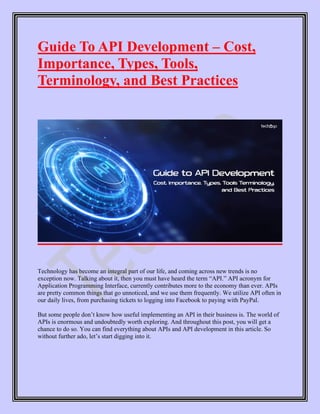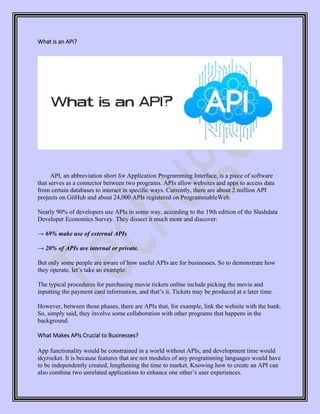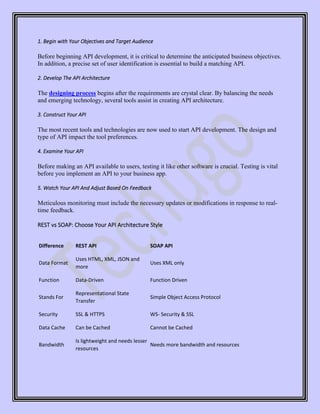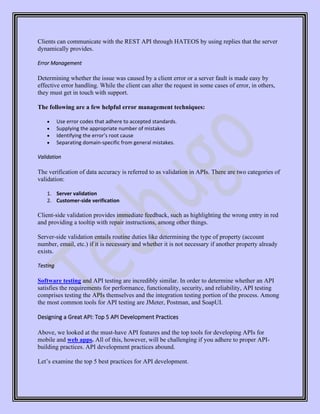Guide To API Development – Cost, Importance, Types, Tools, Terminology, and Best Practices.pdf
- 1. Guide To API Development – Cost, Importance, Types, Tools, Terminology, and Best Practices Technology has become an integral part of our life, and coming across new trends is no exception now. Talking about it, then you must have heard the term “API.” API acronym for Application Programming Interface, currently contributes more to the economy than ever. APIs are pretty common things that go unnoticed, and we use them frequently. We utilize API often in our daily lives, from purchasing tickets to logging into Facebook to paying with PayPal. But some people don’t know how useful implementing an API in their business is. The world of APIs is enormous and undoubtedly worth exploring. And throughout this post, you will get a chance to do so. You can find everything about APIs and API development in this article. So without further ado, let’s start digging into it.
- 2. What is an API? API, an abbreviation short for Application Programming Interface, is a piece of software that serves as a connector between two programs. APIs allow websites and apps to access data from certain databases to interact in specific ways. Currently, there are about 2 million API projects on GitHub and about 24,000 APIs registered on ProgrammableWeb. Nearly 90% of developers use APIs in some way, according to the 19th edition of the Slashdata Developer Economics Survey. They dissect it much more and discover: → 69% make use of external APIs → 20% of APIs are internal or private. But only some people are aware of how useful APIs are for businesses. So to demonstrate how they operate, let’s take an example: The typical procedures for purchasing movie tickets online include picking the movie and inputting the payment card information, and that’s it. Tickets may be produced at a later time. However, between those phases, there are APIs that, for example, link the website with the bank. So, simply said, they involve some collaboration with other programs that happens in the background. What Makes APIs Crucial to Businesses? App functionality would be constrained in a world without APIs, and development time would skyrocket. It is because features that are not modules of any programming languages would have to be independently created, lengthening the time to market. Knowing how to create an API can also combine two unrelated applications to enhance one other’s user experiences.
- 3. For instance, a hotel booking service application can catalog images of its rooms using external APIs, enabling users to examine the spaces before making a reservation. In contrast, the photo service can use APIs to give users the option to search for and reserve hotel rooms, enhancing the functionality of travel apps. What Are the Different Types of APIs: All Categories Explained! Private APIs These APIs are interfaces designed to empower application software to bring top-notch services and solutions within the organization. However, the developers can use such APIs to develop new systems to operate within the organization. In this, only people who work with the API publisher can access the app’s interface only, even if the application is out to the public. By using private APIs, an organization can get complete control over the usage of APIs. Partner APIs Software integration between two parties uses partner APIs. Additionally, they are openly advertised and distributed to business partners through a contract with the publisher. Also, a business can generate additional revenue streams by facilitating the partners with access to data. Moreover, the API providers can monitor the digital assets to evaluate the potential risks. And they ensure the third-party applications that use their APIs provide a good user experience. Additionally, they make sure that their apps maintain their corporate identity.
- 4. Public APIs Also famous as external or developer-facing APIs, public APIs are available for third-party developers. It helps a business to elevate brand awareness while enabling it to earn extra income if used properly. Furthermore, it has two sub-categories: Open API – These are available for public users without any restrictive terms of use. The top advantage of open APIs is that it encourages businesses to integrate with the app that owns the API while making both parties valuable (Third-party and the API). Commercial API – To use commercial APIs, the users can use APIs on a pay-as-you-go basis or get a monthly or annual subscription. However, some publishers offer a free trial to use APIs before any party buys any subscription. Composite APIs When it comes to combining different services and data APIs, composite APIs are the best choice to use. It comprises a combination of existing API functions that perform multiple takes in a single call. As a result, it boosts the execution speed and enhances the listeners’ performance in the interfaces. What is API Development: Definition Building an API is the foundation for any apps dealing with data or requiring communication between two goods or services. A collection of guidelines or standards known as an API allows the software to use the capabilities of another app. For example, when you choose “Connect with Facebook,” Candy Crush immediately gets your Facebook account information. It can access the
- 5. Facebook server using API integration, saving you the trouble of manually entering your information. So it is accurate to claim that it enables apps to communicate with one another and share data without the need for developers. Additionally, API development makes it unnecessary to create comparable programs by allowing you to use already-existing ones. You don’t have to understand the logic underlying an API’s inner workings, which is one of its many advantages. Instead, you give the programming interface a command, and it executes it. Before moving on to how to create an API, its significance, and API development tools, let’s take a closer look at some essential terminologies you should be familiar with and the different types of APIs: API Development: Basic API Terminology to Know • API Key An API key is a unique code or identifier that computer programs use to verify the identity of the calling program, the user, or the developer. • Endpoint The Endpoint is a term used to describe the points at which an API and a server communicate. • JSON APIs use a data format called JSON JavaScript Object Notion (JSON) to exchange data on the internet. For example, a server and a web application can exchange data and two apps. • GET The GET technique can request data from a server at the designated resource. • POST POST is a mechanism for creating or updating resources by sending data to the API server. • OAuth OAuth is a framework or open standard authorization for granting access to APIs. It gives third- party websites and applications secure, constrained access to end users’ data without gaining access to their passwords.
- 6. • Latency Latency is the time it takes for an API to process and respond to a request. • Rate-Limiting Controlling the flow of incoming and outgoing traffic is what it entails. It can also be described as the number of API calls a user makes on a given occasion. • API Throttling Throttling refers to controlling API usage by the user at a particular moment. For example, the server sends an HTTP status message expressing “too many requests” when a user makes more API queries than are permitted for a given day. Tools for API Development Apigee: It is Google’s API development management tool. It is helpful when a developer creates connected apps or a company updates legacy apps or facilitates data transfer between services and apps. Dredd: It is an HTTP API testing framework. It takes an API description document, creates expectations based on requests and responses documented in the document, makes requests to the tested API, checks whether API responses match the documented responses, and validates the results. API Spec Converter: Developers use this tool to convert between different API spec formats. APIMatic: It is a developer experience platform for web APIs. Developers use it for generating SDKs for their APIs for ten platforms and keeping them in sync with the API updates.
- 7. This tool allows developers to convert API descriptions into multiple formats, including Swagger, API Blueprint, IO Docs, OAI format, WADL, RAML, Postman Collections, HAR 1.4, and more. Sandbox: This tool provides a quick mock RESTful API from API definitions. It reduces the cost and risk associated with calling third-party API during testing. Postman: It’s an interactive and automatic tool that allows developers to run, test, document, and evaluate the performance of their API. SoapUI: It is an open-source testing tool. It can operate on cross-platforms and can automate both functional tests as well as non-functional tests. It is generally used to execute Web APIs’ compliance, regression, security, and load tests. Swagger: It is an open-source framework that is used for developing APIs. Swagger is being used by top technology giants such as Apigee, Microsoft, GettyImages, and PayPal. JMeter: It is also open-source software. It is used for performance testing of a RESTful API. How Does an API Work? APIs exchange information using a set of rules that specify how machines, programs, and computers can talk to one another. Any two machines that want to connect for a specific job can use the API as an intermediary. An easy example is when you sign into Google from your phone, allowing access to your account through the Google application. The mobile application retrieves your Google account and login information through an API request. The data would then be returned to the mobile app by Google after being accessed from one of its servers. How To Create An API: The Simplest Guide Creating an API requires lots of thought, consideration, and planning. So, to make it easy for you to develop an API, here are some simple instructions to follow:
- 8. 1. Begin with Your Objectives and Target Audience Before beginning API development, it is critical to determine the anticipated business objectives. In addition, a precise set of user identification is essential to build a matching API. 2. Develop The API Architecture The designing process begins after the requirements are crystal clear. By balancing the needs and emerging technology, several tools assist in creating API architecture. 3. Construct Your API The most recent tools and technologies are now used to start API development. The design and type of API impact the tool preferences. 4. Examine Your API Before making an API available to users, testing it like other software is crucial. Testing is vital before you implement an API to your business app. 5. Watch Your API And Adjust Based On Feedback Meticulous monitoring must include the necessary updates or modifications in response to real- time feedback. REST vs SOAP: Choose Your API Architecture Style Difference REST API SOAP API Data Format Uses HTML, XML, JSON and more Uses XML only Function Data-Driven Function Driven Stands For Representational State Transfer Simple Object Access Protocol Security SSL & HTTPS WS- Security & SSL Data Cache Can be Cached Cannot be Cached Bandwidth Is lightweight and needs lesser resources Needs more bandwidth and resources
- 9. ACID Compliance No ACID Compliance Built-in ACID Compliance Payload Handling No knowledge of the API Has a strict communication contract and needs every detail before communication. REST is quite a toe-to-toe match with Simple Object Access Protocol (SOAP), another method for developing HTTP-based applications. However, REST is a less complicated alternative to SOAP because it requires less code to complete tasks and has a less rigid structure and logic than SOAP. Another reason people like REST is that it provides many conventions while leaving many decisions to the person designing the API. If you’re deciding between REST and SOAP for your API, here’s a simple test: for flexibility, choose REST; for standardization, opt for SOAP. Why Is API Integration Good for a Business App – Top Benefits of APIs Elevate Customer Experience It is evident that APIs enhance app functionality, and so does the user experience of any application. There are many ways in which a business can leverage APIs, such as personalization, data collection, and integration. So, to provide an attention-grabbing user experience, you must contact the top app development company to integrate APIs into your app. It will surely escalate user engagement and make your app successful.
- 10. Builds New Revenue Models APIs can boost the earnings of a business while creating new ways to increase the revenue stream. For example, a company can enable its consumers to make purchases within their apps and earn money from the commissions by growing business growth via payment APIs. In addition, APIs undoubtedly allow digital businesses to adopt new business strategies and generate new revenue streams from their digital assets. Encourages Innovation Businesses profit from innovation when implementing APIs as the need for recent software rises. As a result, a company that invests in innovation and technology today makes a difference more than ever. There are various ways that APIs can promote creativity. But one of the most crucial methods is by giving programmers a way to access information and features from other apps quickly. As a result, the app can offer advanced services and new functionalities. Besides, developers can enhance the functionality of existing systems and gain value from data sources using APIs. So, API integration is an essential part of app development. Improves Customization APIs generally enable customization by facilitating developers to access and use data and functionality from other programs. After API integration, the user experience will be more flexible and personalized. And it empowers developers to modify the website or app content to meet the needs of users and visitors. Most customers expect businesses to comprehend their specific needs and expectations, while the rest expect offers to always be modified. Reduces Expenses and Marketing Time The key advantage of an API-driven strategy is it reduces app development cost, time and results in a quicker time to market. In addition, developers can use APIs to include external features in the app without writing any new code. It happens because they know that most of the functionality already exists elsewhere. In this way, businesses can save time and money, and the app development team can concentrate on creating programs that offer distinctive features. Increase Automation In terms of development agility, APIs are crucial because they are the key to automating an app’s procedures. Through connected applications, previously manual operations become simple
- 11. through API interfaces. As a result, a digital business can be built faster and with less effort using APIs. Therefore, to bring automation to your business, API integration is essential. Must-have features in API design There are a few things you need to keep in mind when you start designing APIs. These ideas will catalyze the development of your API and will keep your team communicating effectively. Let’s examine each of these topics individually. Authorization and Authentication Authentication can be defined as the process of confirming the correct identity. On the other hand, authorization refers to determining if the verified user is authorized to take a particular action on a source. Some of the most popular specifications for handling permission and authentication are OAuth, OAuth2, and JWT. Pagination It goes without saying that your database will expand over time. When that occurs, you’ll notice that some resources are retrieved more slowly than usual. The most typical method for dealing with this problem is creating pagination or caching the objects. Paging is nothing more than a method for deciding how frequently and how much data should be displayed. Additionally, sorting ensures that the user receives the material per their requests, conditions, and alterations. These elements contribute to a quick reaction time, little processing time, and a high level of security. Wrappers API wrappers are language-specific containers or packages. They consolidate several groups of API requests into simple functions. Additionally, the wrapper makes multiple API calls without contacting the user. Cache You can quickly retrieve resources by developing a Cache technique. As a result, your requests will be less expensive after the data is prepared for use in an in-memory database. You can create a Cache strategy using programs like Redis and Memcached. HATEOAS HATEOAS, aka Hypermedia as the Engine of Application State, is one of the REST application architecture’s modules. Hypermedia, in this context, refers to any content that has links to other types of media, such as text, photographs, videos, etc.
- 12. Clients can communicate with the REST API through HATEOS by using replies that the server dynamically provides. Error Management Determining whether the issue was caused by a client error or a server fault is made easy by effective error handling. While the client can alter the request in some cases of error, in others, they must get in touch with support. The following are a few helpful error management techniques: • Use error codes that adhere to accepted standards. • Supplying the appropriate number of mistakes • Identifying the error’s root cause • Separating domain-specific from general mistakes. Validation The verification of data accuracy is referred to as validation in APIs. There are two categories of validation: 1. Server validation 2. Customer-side verification Client-side validation provides immediate feedback, such as highlighting the wrong entry in red and providing a tooltip with repair instructions, among other things. Server-side validation entails routine duties like determining the type of property (account number, email, etc.) if it is necessary and whether it is not necessary if another property already exists. Testing Software testing and API testing are incredibly similar. In order to determine whether an API satisfies the requirements for performance, functionality, security, and reliability, API testing comprises testing the APIs themselves and the integration testing portion of the process. Among the most common tools for API testing are JMeter, Postman, and SoapUI. Designing a Great API: Top 5 API Development Practices Above, we looked at the must-have API features and the top tools for developing APIs for mobile and web apps. All of this, however, will be challenging if you adhere to proper API- building practices. API development practices abound. Let’s examine the top 5 best practices for API development.
- 13. Throttling When it comes to redirecting overflow traffic, protecting against DoS (Denial of Service), and backing up APIs, app throttling is the best practice you should all consider. Enable HTTP method override Some proxies only support the POST and GET methods; therefore, you must allow your RESTful API to override the HTTP method. This can be accomplished by using the custom HTTP Header X-HTTP-Method-Override. Libraries and SDK Provide critical resources to the development team to accelerate the development and implementation of services. You can accomplish this by providing resources that include reusable processes and code. Security You must ensure that your API is secure without sacrificing usability. For example, if a user spends more than 5 minutes on authentication, it indicates that your API could be more user- friendly. To make your API more secure, you can use token-based authentication. Documentation Another excellent practice to consider is providing a wide range of documentation. You must create extensive documentation for an API so that other mobile app developers can fully understand the entire process and use it to provide an excellent user experience. Well-crafted API documentation will lower project costs, shorten implementation time, and improve API efficiency. What is an API Development Cost? A Real Question! The cost of developing an API relies on its features, types, etc. An accessible API may often cost you roughly 20,000 USD. This is because it comprises the development of fully functional APIs, secure design, and documentation. However, the cost may vary depending upon the need and purpose of API integration to the app. So, you must contact an app development company to discuss your business ideas. Want to Create an API for Your Next Mobile App? After going through a detailed guide on API development, you must know everything about it. Still, API development is crucial if you want to market your mobile app faster and improve the
- 14. user experience. Businesses could also benefit from the integration of cutting-edge technology through APIs. It offers a richer experience and lower total development costs. While developers can benefit from automatic process updates through APIs, which are quicker and more efficient than others, it allows for personalization and flexible service delivery while improving operational efficiency. So, if you want to create an API for your business, connect with the experts. Techugo has a team of experts who are always ready to integrate the latest and trending technology to provide you with tech solutions—having experience serving clients worldwide and developing more than 800 mobile applications for different industries. Don’t waste even a second thinking about whether you should develop an API for your business. Instead, immediately make a phone call to get in touch with the top technology partner and start the API development project. Contact Us A-26, Lohia Rd, A Block, Sector 63, Noida, Uttar Pradesh 201301 096671 34400 [email protected] https://www.techugo.com/ ***Thankyou***














